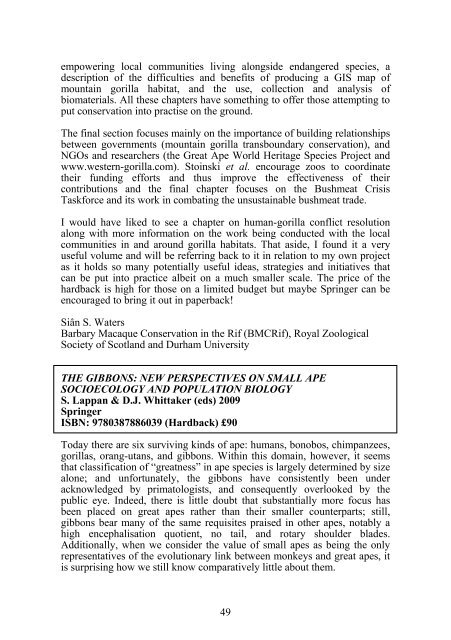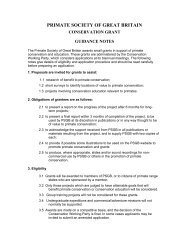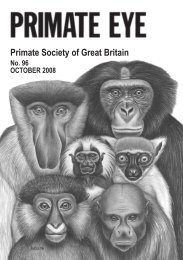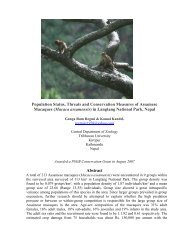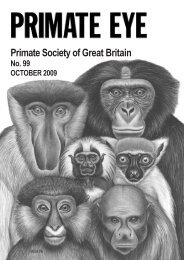2010 Vol 101.pdf (1.63mb) - Primate Society of Great Britain
2010 Vol 101.pdf (1.63mb) - Primate Society of Great Britain
2010 Vol 101.pdf (1.63mb) - Primate Society of Great Britain
Create successful ePaper yourself
Turn your PDF publications into a flip-book with our unique Google optimized e-Paper software.
empowering local communities living alongside endangered species, a<br />
description <strong>of</strong> the difficulties and benefits <strong>of</strong> producing a GIS map <strong>of</strong><br />
mountain gorilla habitat, and the use, collection and analysis <strong>of</strong><br />
biomaterials. All these chapters have something to <strong>of</strong>fer those attempting to<br />
put conservation into practise on the ground.<br />
The final section focuses mainly on the importance <strong>of</strong> building relationships<br />
between governments (mountain gorilla transboundary conservation), and<br />
NGOs and researchers (the <strong>Great</strong> Ape World Heritage Species Project and<br />
www.western-gorilla.com). Stoinski et al. encourage zoos to coordinate<br />
their funding efforts and thus improve the effectiveness <strong>of</strong> their<br />
contributions and the final chapter focuses on the Bushmeat Crisis<br />
Taskforce and its work in combating the unsustainable bushmeat trade.<br />
I would have liked to see a chapter on human-gorilla conflict resolution<br />
along with more information on the work being conducted with the local<br />
communities in and around gorilla habitats. That aside, I found it a very<br />
useful volume and will be referring back to it in relation to my own project<br />
as it holds so many potentially useful ideas, strategies and initiatives that<br />
can be put into practice albeit on a much smaller scale. The price <strong>of</strong> the<br />
hardback is high for those on a limited budget but maybe Springer can be<br />
encouraged to bring it out in paperback!<br />
Siân S. Waters<br />
Barbary Macaque Conservation in the Rif (BMCRif), Royal Zoological<br />
<strong>Society</strong> <strong>of</strong> Scotland and Durham University<br />
THE GIBBONS: NEW PERSPECTIVES ON SMALL APE<br />
SOCIOECOLOGY AND POPULATION BIOLOGY<br />
S. Lappan & D.J. Whittaker (eds) 2009<br />
Springer<br />
ISBN: 9780387886039 (Hardback) £90<br />
Today there are six surviving kinds <strong>of</strong> ape: humans, bonobos, chimpanzees,<br />
gorillas, orang-utans, and gibbons. Within this domain, however, it seems<br />
that classification <strong>of</strong> “greatness” in ape species is largely determined by size<br />
alone; and unfortunately, the gibbons have consistently been under<br />
acknowledged by primatologists, and consequently overlooked by the<br />
public eye. Indeed, there is little doubt that substantially more focus has<br />
been placed on great apes rather than their smaller counterparts; still,<br />
gibbons bear many <strong>of</strong> the same requisites praised in other apes, notably a<br />
high encephalisation quotient, no tail, and rotary shoulder blades.<br />
Additionally, when we consider the value <strong>of</strong> small apes as being the only<br />
representatives <strong>of</strong> the evolutionary link between monkeys and great apes, it<br />
is surprising how we still know comparatively little about them.<br />
49


